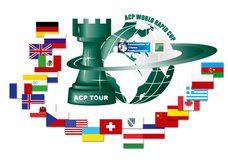Despite the bloodiness of the round, (only 4 draws on the top 25 boards, three on 1-2-3, the other between local Expert Peter Hum, on this event's Organizing Committee, and apparent Drawing Machine :-), Nikolay Noritsyn, of Toronto), the big logjam at the top has reduced to two joint leaders, GM David Howell of England, and GM Suat Atalik of Turkey. Both have 5 points out of 6 games.
Once again, GM Short's game was unavailable (I hope for posterity, the organizers are saving the handwritten scoresheets and adding to .pgn files later!), but I have heard rumours to the effect that his game tomorrow should be...I am not sure why, but will be eager to find out! He apparently played a solid Nimzo-Indian against GM Rytchagov and a draw was agreed. GM Sergey Tiviakov was allowed to offer a draw before move 30 this round (for huminatarian reasons, he had some delicate oral surgery performed earlier in the day), and GM Alex Yermolinsky, playing the Black side of a Caro-Kann decided not to torture him (literally), and agreed an early peace. Only the game between Canadian GM Mark Bluvshtein and GM Kamil Miton of Poland (on Board 2) had a few fireworks, but they were mostly theoretical in nature, and that soon petered out as well:
Bluvshtein - Miton: Slav Defence
1.d4 d5 2.c4 c6 3.Nf3 Nf6 4.Nc3 dxc4 5.a4 Bf5 6.Ne5 e6 7.f3 c5!?
An interesting alternative to the heavily analyzed piece sac, 7...Bb4 8.e4 Bxe4 9.fxe4 Nxe4 10.Bd2 Qxd4 11.Nxe4 Qxe4+ 12.Qe2 Bxd2+ 13.Kxd2, where the theoretical evaluation has flipped back and forth several times over the years of praxis.
8.e4 cxd4 9.exf5 Bb4 10.Bxc4 dxc3 11.Qxd8+ Kxd8 12.0–0
I am reasonably certain that I tried 12.Ke2!? in this position against IM David Cummings of Wales (or is it England?) at the Toronto International Open in the early 1990's. That game was also drawn, but we spent some time trying to decide where White's King belonged, and Mark's move is likely a bit better to maintain options of immediate pressure along the e-file on the e6-pawn.
12...cxb2 13.Bxb2 Ke7 14.fxe6 fxe6 15.Nd3!? Rc8! 16.Bb3 a5
I was advocating 16...Nc6 as likely in the commentary room. 17.Nxb4 Nxb4 18.Ba3 a5 is nothing special, as attacks on e6 with Rfe1 can be met laterally on the 3rd rank now. English GM Matthew Sadler in his Chess Press booklet on the Slav recommends this move, so it may be that I recalled seeing it there as well. Miton's choice is also quite reasonable, maintaining the orbit ...N/b8-d7-c5!? in reserve perhaps, attacking B/b3 and guarding P/e6.
17.Nxb4 axb4 18.Rfe1 Rc6 19.Bxf6+
Playing to flatten the position, but there isn't much else. A draw is likely just around the corner.
19...Kxf6 20.Re4 Na6 21.Rae1 Nc5
Same destination, different route.
22.Rf4+! Ke7 23.Rxb4 Nxb3 24.Rxb7+
This intermezzo wins back the pawn and leads to dead equality. White's 22nd was important to ultimately force Black's King onto a tactically vulnerable square. Otherwise, Black would have been able to win material after Rxb4 with a ...Nd3 fork of rooks.
24...Kf6 25.Rxb3 Rxa4 26.Rbe3
Now the players shuffle pieces until move 30 (oops, did I say that?). I'm sure they were just gauging there final winning chances (nudge, nudge, wink, wink)...
26...Rac4 27.R1e2 Kf7 28.Kf2 Rc3 29.Rxc3 Rxc3 30.h3 Kf6 31.Kg3 ½–½.
Thursday, July 12, 2007
Subscribe to:
Post Comments (Atom)



No comments:
Post a Comment